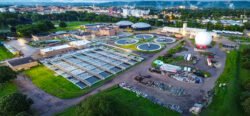Wastewater Conveyance System
Understanding Wastewater Conveyance Systems: A Comprehensive Overview
Wastewater conveyance systems are a crucial component of modern urban infrastructure, managing the transport of sewage and stormwater from residential, commercial, and industrial sources to treatment facilities. An efficient system is vital for maintaining public health, protecting the environment, and supporting sustainable urban development. This article delves into the essential aspects of wastewater conveyance systems, including their design, components, challenges, and future innovations.
Introduction
Wastewater conveyance systems have been integral to human civilizations since ancient times. From the advanced sewer systems of the Roman Empire to the contemporary networks of pipes and pumps in modern cities, the evolution of these systems reflects our growing understanding of public health and engineering. The primary purpose of wastewater conveyance is to ensure that waste is efficiently and safely transported from the site of generation to a treatment facility, where it can be processed and disposed of without harming the environment.
Components of Wastewater Conveyance Systems
Collection Networks
The collection network is the backbone of any conveyance system. It comprises pipes, manholes, and other structures that gather and transport wastewater from its source to the treatment facility. These networks can be broadly classified into two categories:
- Sanitary Sewers: Designed specifically for transporting domestic and industrial wastewater without inclusion of stormwater.
- Combined Sewers: These systems handle both wastewater and stormwater runoff. While economically beneficial, combined sewers can lead to overflow problems during heavy rainfall events.
Pumping Stations
In regions where gravity cannot sustain wastewater flow, pumping stations provide the necessary energy to move waste toward the treatment plants. These stations include pumps, control systems, and often power backup solutions to ensure continuous operation.
Force Mains
Force mains are pressurized pipelines that carry wastewater from pumping stations to higher elevations, facilitating the movement where gravitational flow is insufficient. The design of force mains takes into account factors like flow rate, velocity, and pressure to prevent pipe bursts and reduce maintenance needs.
Design Considerations
Hydraulic Design
Effective hydraulic design is critical for ensuring that the conveyance system can handle variable flow rates without incidents like backflows or overflows. The hydraulic gradient, pipe sizes, and material selections are all based on expected maximum flow scenarios.
Structural Design
Pipelines must be structurally sound to withstand external loads, internal pressure, and corrosive environments. Engineers use materials like reinforced concrete, PVC, and ductile iron, each chosen based on durability, cost, and local conditions.
Environmental and Regulatory Compliance
Wastewater systems must comply with environmental regulations to prevent pollution and environmental degradation. Engineers must account for potential impacts on ecosystems when designing new systems, ensuring that projects adhere to local, regional, and national environmental standards.
Challenges of Wastewater Conveyance Systems
Aging Infrastructure
One of the most pressing challenges is the aging nature of much of the world’s wastewater infrastructure. Many systems, especially in older cities, were constructed decades ago and require urgent upgrades or replacements to handle current and future demand.
Capacity Issues
Urban population growth and increased storm intensity due to climate change place higher demands on existing systems, which may not be designed for such loads, resulting in overflow events and water contamination risks.
Infiltration and Inflow
Infiltration refers to groundwater entering sewer systems through cracks, while inflow describes the entry of stormwater through improper connections or openings. Both phenomena can overwhelm a system’s capacity, leading to overflows.
Maintenance and Rehabilitation Strategies
Regular Inspections
Routine inspections using CCTV and other technologies help identify potential issues such as blockages, leaks, and structural weaknesses before they become severe problems.
Pipe Rehabilitation Techniques
Techniques such as cured-in-place pipe (CIPP) lining, slip lining, and pipe bursting allow for the repair of existing pipelines without the need for extensive excavations, reducing both costs and disruptions.
Smart Monitoring Systems
Advanced monitoring systems that utilize IoT technology can provide real-time data on flow rates, pressure, and potential blockages, allowing for proactive maintenance and rapid response to emerging issues.
Innovations and Future Directions
Green Infrastructure Integration
Incorporating green infrastructure such as rain gardens, permeable pavements, and green roofs can reduce stormwater runoff entering conventional systems, alleviating pressure on existing networks and enhancing sustainability.
Decentralized Treatment Systems
Decentralized systems treat wastewater closer to its source, reducing the demand on central conveyance systems and allowing for the reuse of treated water in irrigation and industrial processes.
Advanced Materials
Ongoing research into advanced materials promises to extend the lifespan and efficiency of pipes. Self-healing concrete and advanced composites could help mitigate the challenges posed by corrosion and mechanical stress.
Digital Twin Technology
Creating digital twins of wastewater systems allows engineers to simulate different scenarios, optimize system performance, and plan more effective maintenance strategies, bridging the gap between physical infrastructure and digital innovation.
Conclusion
Wastewater conveyance systems are indispensable for modern urban life, representing complex integrations of engineering and environmental stewardship. While these systems face significant challenges due to aging infrastructure, capacity limitations, and evolving environmental pressures, the future offers promising innovations. By integrating green infrastructure, leveraging advanced materials, and embracing digital technologies, cities can build resilient wastewater systems that protect public health and the environment while supporting sustainable growth.
Advancements in understanding the dynamics of wastewater conveyance—alongside a commitment to maintenance and strategic investment—will ensure that these systems continue to function effectively. As we navigate the complexities of urbanization and climate change, the importance of robust wastewater infrastructure will only grow, reinforcing the need for ongoing innovation and collaboration across disciplines. Thus, the continued evolution of wastewater conveyance systems will remain a cornerstone of sustainable urban development.



